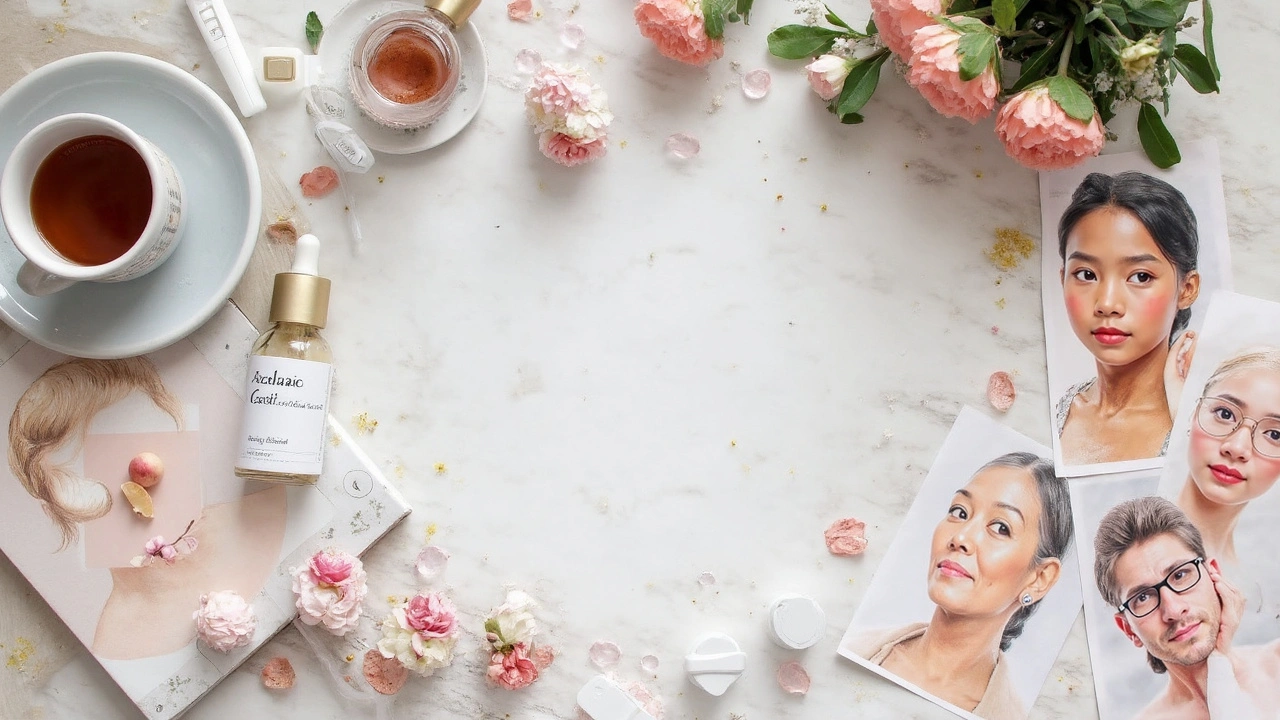Azelaic Acid for Acne Scars: Does It Really Improve Skin Texture?
12 May, 2025If acne scars feel like the final boss after you thought you beat the acne game, you’re not the only one. That mix of dark marks, bumpy skin, and just a general feeling like your face was the battleground for your teenage years? It’s frustrating. But there’s a hard-to-pronounce ingredient you might’ve seen floating around: azelaic acid. People whisper that it’s a game-changer for texture and those stubborn post-breakout marks. But is it just hope in a tube, or does it actually work?
What Exactly Is Azelaic Acid—and Why Are People Into It?
Azelaic acid sounds pretty hardcore, but it’s actually found in grains like barley and wheat. In skincare, you’ll usually get the lab-made version, which is way more stable and effective. Unlike some harsh acids that make you peel like a snake, azelaic acid is in a friendlier league. Dermatologists have used it for decades, first mostly for rosacea and weird redness nobody understood. But lately, it’s earned a reputation for attacking the leftover messes that acne leaves behind—like dark spots (that’s called post-inflammatory hyperpigmentation, if you want the sciencey term), lingering redness, and even those annoying skin lumps you want to sand down.
Azelaic acid works in a few very cool ways. It’s an exfoliant—kind of like a less intense version of your classic AHAs or BHAs, so it helps loosen up the glue that keeps dead skin cells stuck, keeping your pores clear and your skin smoother. But that’s only half the story. Azelaic acid actually blocks an enzyme called tyrosinase. Why do you care? That’s the one in charge of making melanin, so when you block it, you can fade dark marks and even out skin tone, especially if you’re fighting the lingering souvenir of every pimple you’ve ever popped. And it’s a bacteria-fighting ninja, too—good news for people with both active breakouts and the marks they leave behind.
Here’s a stat: According to a 2023 clinical review, using 15%-20% azelaic acid for at least twelve weeks led to visible improvement in post-acne scarring and a 60% reduction in pigmentation for tested users. It’s not a miracle overnight, but the results get better the longer you stick with it. And while retinoids and hydroquinone also work on texture and dark marks, azelaic acid is noticeably less irritating. People with melanin-rich skin, who deal with darker marks longer, find it a solid choice since it fades pigment without the risks of bleaching or rebound redness.
Here’s why it’s blowing up: Most folks can actually tolerate it—even people who get red and itchy just thinking about acids. There’s also evidence it helps zap those annoying closed comedones (those weird skin-colored bumps that never pop, just hang around). Count that as a win for texture lovers. Not flashy, but reliable. And if you like multitaskers, azelaic acid also has some gentle anti-bacterial and anti-inflammatory powers, meaning you’ll see less redness and swelling during a breakout if you add it to the routine.

What Can Azelaic Acid Actually Do for Acne Scars and Texture?
All right, the brass tacks—how good is this stuff when it comes to the actual scars and bumps you want gone? First, a quick reality check: azelaic acid can do a lot for flat, dark marks and post-inflammatory redness, but it’s not a laser treatment or magic eraser. For deep, indented scars (think icepick or boxcar scars), results will be way more subtle. But if the main issue is discoloration, uneven skin tone, and mild-to-moderate roughness, it can genuinely move the needle.
Azelaic acid shines brightest with hyperpigmentation. Studies have logged improvements of up to 60% in brown marks after a few months of steady use—usually 12 to 24 weeks. The secret? Azelaic acid slows down pigment-producing cells but doesn’t shut them off entirely, so you’re unlikely to end up with weird white patches (unlike what can sometimes happen with really strong bleaching agents). A lot of users with medium to dark skin tones say it’s the only product they’ve found that fades marks without messing with their natural skin color, which is a huge deal.
Now about texture—azelaic acid can help smooth things out, especially if you’re dealing with leftover roughness, tiny bumps, or skin that never feels quite even after a breakout. Azelaic acid helps by kickstarting gentle cell turnover, meaning you shed dead skin at the surface before it piles up. That’s why your skin can start feeling more “normal” to the touch after consistent use. According to a double-blind clinical trial from 2022, 82% of participants noticed smoother skin texture after using 15% azelaic acid gel for 16 weeks vs 42% with placebo.
Check this out: azelaic acid doesn’t just fade what’s there—it can actually help prevent new post-acne spots by calming down inflammation and stopping pigment-crazy cells from going into overdrive when you get a breakout. If you’re still breaking out, it’s a twofer: less acne now, less drama later.
| Parameter | Results after 12 Weeks | Results after 24 Weeks |
|---|---|---|
| Hyperpigmentation Fade (%) | 43% | 60% |
| Smoother Skin Texture (users reporting "noticeable improvement") | 54% | 82% |
| Reduction in Active Breakouts | 38% | 51% |
| Incidence of Irritation | 11% | 9% |
If you stack it up against heavy-hitters like retinoids, azelaic acid might seem less dramatic at first, but its big advantage is how sneaky it is. You don’t get major purging, dry flakes, or flaming red patches. It just quietly puts in work, and that’s usually what makes people stick with it until those actual results show up. Another bonus? You can often use it along with other treatments (vitamin C, niacinamide, even retinol for some people), so it plays nicely if you want to build a power squad for your skin issues.
This also makes it super flexible for anyone who just doesn’t want to risk walking around with flaking or burning, especially if you’ve got sensitive skin, rosacea, or you’re balancing a million other things already. Even pregnant and breastfeeding people can use azelaic acid (ask your doctor, but most give the thumbs up), which isn’t the case for a lot of hardcore acne-fighters.

How to Use Azelaic Acid for the Best Results—and What Mistakes to Avoid
It’s pretty tempting to slather on azelaic acid and binge skincare TikToks, but a smarter approach gets you way better results—and skips the irritation rookie mistakes. The usual starting point for over-the-counter products is 10%, but prescription-strength stuff can hit 15-20%. Unless your doctor tells you otherwise, starting lower and moving up as your skin gets used to it is the smarter bet. Yes, the strong stuff works faster, but the mild stuff is still surprisingly solid, especially for sensitive skin.
Think of azelaic acid as your after-cleansing, pre-moisturizer serum or gel. Put it on clean, dry skin, and let it absorb for a minute. You technically can use it both morning and night, but most people start with once a day, then work up as you see fit. Pairing it with a good sunscreen is absolutely not optional if you want those scars to fade—sun exposure makes dark marks worse, and azelaic acid makes your skin a little more sensitive to sunlight. That means SPF 30 (minimum) becomes your new BFF. And don’t over-complicate your routine: skip things that make you peel (like harsh scrubs or strong acids) until your skin gets used to azelaic acid. Layering too many actives can give you redness, stinging, or weird rashes you can’t blame on your pillowcase.
If you’re working with prescription azelaic acid (like Finacea or Azelex), expect it to feel a bit stronger—maybe a light tingling or stinging the first few applications. That tends to fade as your skin adapts, but don’t keep pushing through if you’re getting crazy uncomfortable. Sometimes, a gentler drugstore version is better for long-term use if your face is sensitive or you’re already using retinoids or acids elsewhere. For the maximalist types, azelaic acid is usually safe to pair with niacinamide (for redness and barrier repair) or hyaluronic acid (for hydration), and even a lot of vitamin C products, as long as you go slow and don’t dump everything on at once.
Some things to keep in mind:
- Azelaic acid won’t usually make you “purge”—so if you’re getting worse breakouts, something else is probably to blame.
- If you see no change after 2-3 months of daily use, check with a dermatologist before scrapping it—sometimes it just needs to be at a higher strength, or paired with other things.
- Be patient. The super visible changes in texture or color usually show up around the 8-12 week mark, not days. Take progress selfies under the same light if you want to keep motivated.
- Layer under sunscreen in the day, but skip other exfoliants or retinoids for the first couple weeks if you’re brand new to acids.
- Don’t be alarmed if it pills or feels gritty with certain moisturizers—it’s not dangerous, just annoying. Try letting it sink in longer between layers or switching up formulations.
A few brands to look for in stores: The Ordinary Azelaic Acid Suspension 10% is wallet-friendly and easy to find, while Paula’s Choice 10% Azelaic Acid Booster is smoother and layers well. For the strong stuff, you’ll need a doctor, but those with serious scarring or resistant marks often say that step up makes a difference after months of OTC hit-or-miss. And don’t forget, azelaic acid doesn’t play favorites with skin color—it works for every tone, and people with darker skin, especially, shout about how it fades marks without leaving them weirdly pale.
So, is azelaic acid going to totally transform your skin’s texture and wipe out every scar? It depends. If you’re dealing with leftover dark marks, persistent redness, or skin that’s rough and uneven but not deeply pitted, it’s got legit science and user love behind it. For deep scarring, it’ll take more firepower, but azelaic acid can be an awesome, gentle base to get you closer to the skin you want, with way fewer side effects than the hardcore stuff. It’s a marathon, not a sprint—but your face might just thank you for sticking around for the long run.

John Moore
July 18, 2025 AT 06:53I've been using azelaic acid for a few months now and honestly, the difference in my skin texture is pretty noticeable. Those annoying bumps that wouldn’t go away? Way smoother. But I do wonder if it’s mostly because I’ve combined it with other skincare products, like niacinamide and a gentle exfoliant.
From what I understand, azelaic acid helps by killing the bacteria that cause acne and by promoting cell turnover, which might explain how it fades scars and smooths the skin. The brightening effect is a real bonus too, especially on those stubborn dark spots.
One thing I’d say to anyone thinking about it: start slow and patch test. It can sting a bit if your skin’s sensitive. Also, consistency is key with this stuff — no overnight miracles.
Anyone else tried it with other acids or treatments? Curious how it mixes with, say, retinoids or vitamin C.
Adam Craddock
July 22, 2025 AT 12:26The mechanistic aspect of azelaic acid is quite fascinating. It’s not just an antibacterial agent but also an inhibitor of tyrosinase, which explains its efficacy in reducing hyperpigmentation. However, I remain cautious about overstating its benefits without more rigorous comparative clinical data against other topicals like retinoids or hydroxy acids.
Additionally, I would appreciate any insights into how azelaic acid affects different skin types across demographics, considering that formulation and concentration could drastically influence outcomes.
Has there been any longitudinal study that specifically evaluates scar remodeling? That would really settle whether it genuinely improves dermal matrix reconstruction or simply gives a cosmetic overlay effect.
Kimberly Dierkhising
July 26, 2025 AT 18:00From a dermato-cosmetic standpoint, azelaic acid is quite a multipurpose molecule thanks to its ability to exert anti-inflammatory, comedolytic, and melanosomal-modulating activities. It’s quite a versatile ingredient in a skin regimen aimed at addressing post-inflammatory hyperpigmentation and textural inconsistencies.
However, it’s imperative for users to integrate azelaic acid with comprehensive photoprotection and adjunct agents like antioxidants for synergistic efficacy and minimizing irritancy profiles.
To really see substantial improvements in scar topology, expect a treatment duration of at least 8-12 weeks, and maintain a strict application routine. This compound doesn’t work if it’s used intermittently or under-protected from UV exposure.
Also, concentration matters — typical efficacious ranges float between 15-20%, which coincides with FDA-approved topical formulations.
Rich Martin
July 30, 2025 AT 23:33Let’s not get caught in the skincare marketing fluff. Azelaic acid is just one player in a sea of active ingredients promising miracle results. The truth is, acne scars are complex dermal injuries that don’t just vanish with topical creams.
Sure, azelaic acid can help reduce inflammation and pigmentation, but if we think it’s going to rebuild collagen or fully erase texture, we’re fooling ourselves.
If you want serious results, consider combining it with treatments like microneedling or laser therapy. Topicals are a piece of the puzzle, but not the whole picture.
What’s frustrating is how many people expect a quick fix from a bottle. Real skin transformation demands patience, investment, and sometimes professional intervention.
Buddy Sloan
August 4, 2025 AT 05:06Hey folks, just chiming in here :) From personal experience, azelaic acid helped me a lot with my post-acne marks, but it was a slow process — took about 3-4 months to notice them fading significantly. What helped even more was pairing it with a good sunscreen and some gentle daily moisturizer.
Anyone else find it stings sometimes? I found it wasn’t too bad once my skin adjusted.
Also, the brightening effect was definitely noticeable, which is a nice perk beyond texture smoothing.
Would love to hear if anyone managed to speed up results or combined it with other treatments safely.
SHIVA DALAI
August 8, 2025 AT 10:40In my perspective, azelaic acid is far from being the panacea many online claim it is. I have tried multiple brands and formulations, with no significant improvement on the deeper, pitted scars.
The hype often neglects the fact that topical application rarely penetrates deep enough to remodel skin architecture meaningfully.
It may smooth out minor imperfections and reduce redness, but it does not replace professional treatments that physically resurface the skin.
It's crucial to be realistic and not fall for dramatic before-and-after pictures that exaggerate typical outcomes.
Vikas Kale
August 12, 2025 AT 16:13Just to add a bit of scientific context from my pharmacology background, azelaic acid’s dual ability to inhibit microbial growth and downregulate keratinocyte hyperproliferation makes it valuable against acne and rosacea alike.
Still, the clinical efficacy for scar improvement is often modest and dependent on concentration, vehicle formulation, and user compliance.
Don’t forget it also displays free radical scavenging properties which contribute to its anti-inflammatory effects.
Moreover, the formulation pH can hugely affect its stability and penetration, so choosing pharmaceutical-grade products over cosmetic ones is vital.
Deidra Moran
August 16, 2025 AT 21:46Honestly, this whole azelaic acid craze seems a bit overstated to me. It's just another chemical agent pushed by the skincare industry to boost sales.
Why do we completely ignore the role of diet, stress, and environmental toxins in skin health? I bet if more people focused on holistic wellness, we wouldn’t need to rely so heavily on these supposed miracle acids.
Also, watch out for companies that hide behind fancy clinical jargon while skimping on real transparency with their ingredients.
People deserve better education instead of chasing the next trendy product.
Zuber Zuberkhan
August 17, 2025 AT 06:53From my experience, combining azelaic acid with a regimen focused on reducing inflammation and supporting skin barrier function works best. For instance, using a gentle cleanser, niacinamide serum, and rich moisturizer along with azelaic acid yields the most consistent improvements.
Being aggressive about sun protection is non-negotiable because UV exposure can exacerbate pigmentation triggered by acne scars.
Patience is key: Visible changes take time, often several months, but with perseverance, it’s possible to achieve meaningful skin texture refinement.
Azelaic acid shouldn't be seen as a quick fix but part of a holistic, tailored skin wellness program.
Tara Newen
August 16, 2025 AT 06:00As someone who has spent years diving deep into skincare science, I can confidently say that ignoring azelaic acid’s multifactorial properties is a major oversight. It’s not just for fading scars but regulates keratinocyte proliferation, lessening follicular plugging and inflammation simultaneously.
Still, one must use pharmaceutical-strength formulations and commit long-term for tangible results. Spot treatments won't cut it.
Furthermore, the synergy with other actives like glycolic acid or retinol can amplify outcomes when formulated or layered correctly.
It’s vital to distinguish gimmicks from genuine, evidence-based skincare actives — azelaic acid definitely falls in the latter category.
Amanda Devik
August 13, 2025 AT 15:46Yes! Azelaic acid is a total game-changer, especially for those struggling with discoloration after acne. It’s gentle yet effective in improving skin clarity and evening out texture.
One thing I emphasize when coaching is going easy at first — introduce it slowly to let your skin build tolerance.
Also, combining it with hydration boosters and antioxidants not only calms irritation but enhances healing and protects new skin layers.
If you’re consistent and patient, you will definitely see positive changes. It’s about building a sustainable skincare routine, not sprinting for quick fixes.